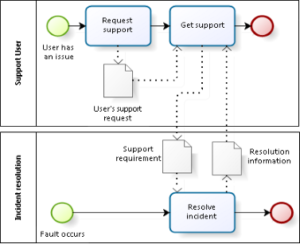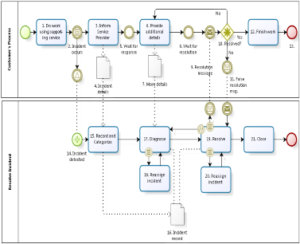A vicious cycle in incident management Lean incident management is the resolution of incidents in a manner respecting lean principles. Being lean allows us to significantly reduce the extent of the control activities in the process and the number of organizational roles created to exercise those control activities. For, I have often seen a vicious […]
Incident Management
BPMN & service management
BPMN: a step toward automation I have argued elsewhere that the typical service management tools in use today might be suitable for service desk agents, but are annoying, redundant and of little value to anyone else involved in resolving incidents, among other activities. I have further proposed that existing IT management should be leveraged to […]
The Goal of Incident Management
ITIL®‘s version of the goals of incident management According to the latest version of ITIL®, the goal of incident management is “…to restore normal service operation as quickly as possible and minimize the adverse impact on business operations…”¹ So there are really two goals mentioned: to restore as quickly as possible and to minimize impact. […]
Types of Tool Automation
Types of tool automation The fundamental difference between a software tool and most types of tools is that software can be programmed to automate one or more tasks. Most other tools do not automate work at all, only extending the capabilities of the wielder of the tool. Certain mechanical tools can automate a task, but, […]
Objective Urgency
Little urgency; less impact It is a paradox that most organizations understand incident impact fairly well, but find it difficult to measure, whereas their understanding of urgency leaves something to be desired, but it is not so difficult to measure at all. Some of the confusion is due to the so-called “best practice” of calculating […]
The causes of incidents
Are 80% of incidents really caused by changes? In a recent thread, it was advanced that 80% of incidents were caused by changes. Since that figure does not correspond to any experience I have had with any organization, I thought it would be worthwhile to investigate a little how some organizations perceive the causes of […]
Patterns of incident handling
Incident management is halfway between BPM and ACM I have discussed elsewhere in these columns the relationship between process-oriented work and adaptive case management. This framework will help us to refine the understanding of how incidents may best be handled. Incident handling is a good example of work that has features of process-oriented work, such […]
How many incident models should you have?
I recently made a presentation, in the context of the TFT12 event, on techniques for advanced incident management. One of the important tools to use is the incident model. During the presentation, a tweet was made by a listener asking if the number of different incidents types, and hence models, would get out of hand. […]




